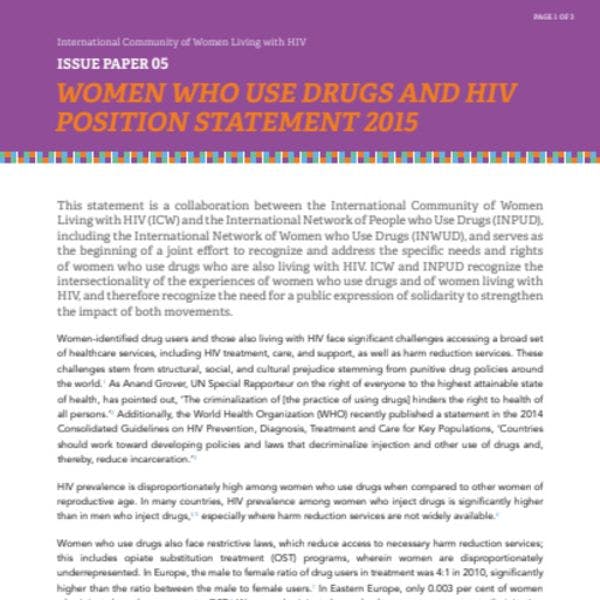Les consommatrices de drogue et le VIH: prise de position 2015
Cette déclaration est le début d'un effort conjoint de reconnaissance des droits et des besoins spécifiques des consommatrices de drogues qui vivent également avec le VIH. Pour en savoir plus, en anglais, veuillez lire les informations ci-dessous.
Abonnez-vous à l'Alerte mensuelle de l'IDPC pour recevoir des informations relatives à la politique des drogues.
Joint statement also released in partnership with the International Community of Women Living with HIV (ICW)
Women-identified drug users and those also living with HIV face significant challenges accessing a broad set of healthcare services, including HIV treatment, care, and support, as well as harm reduction services. These challenges stem from structural, social, and cultural prejudice stemming from punitive drug policies around the world. As Anand Grover, UN Special Rapporteur on the right of everyone to the highest attainable state of health, has pointed out, ‘The criminalization of [the practice of using drugs] hinders the right to health of all persons.’ Additionally, the World Health Organization (WHO) recently published a statement in the 2014 Consolidated Guidelines on HIV Prevention, Diagnosis, Treatment and Care for Key Populations, ‘Countries should work toward developing policies and laws that decriminalize injection and other use of drugs and, thereby, reduce incarceration.’
HIV prevalence is disproportionately high among women who use drugs when compared to other women of reproductive age. In many countries, HIV prevalence among women who inject drugs is significantly higher than in men who inject drugs, especially where harm reduction services are not widely available. Women who use drugs also face restrictive laws, which reduce access to necessary harm reduction services; this includes opiate substitution treatment (OST) programs, wherein women are disproportionately underrepresented.
In Europe, the male to female ratio of drug users in treatment was 4:1 in 2010, significantly higher than the ratio between the male to female users. In Eastern Europe, only 0.003 per cent of women who inject drugs have access to OST. Women who inject drugs also have poor access to sterile injecting equipment and condoms, as well as limited access to sexual and reproductive health (SRH) services. These service shortfalls are particularly acute in prisons and other closed settings. Vertical transmission of HIV amongst women who use drugs is significantly higher than among other women living with HIV.
Keep up-to-date with drug policy developments by subscribing to the IDPC Monthly Alert.
